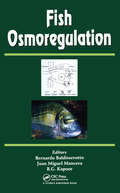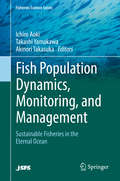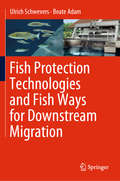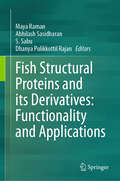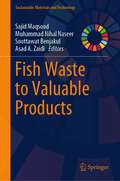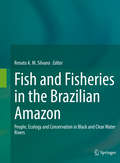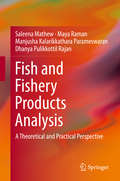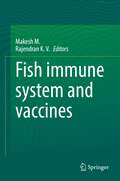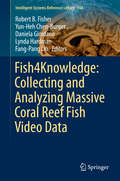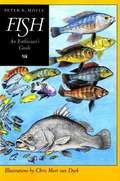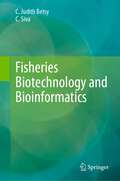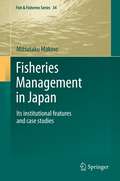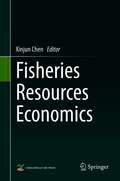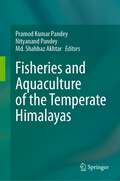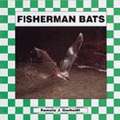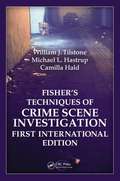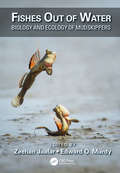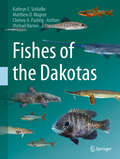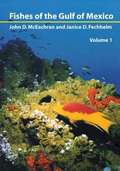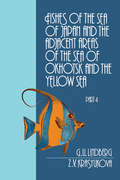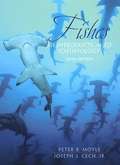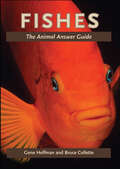- Table View
- List View
Fish Osmoregulation
by B. G. Kapoor Bernardo Baldisserotto Juan Miguel ManceraFish lives in environments with a wide variety of chemical characteristics (fresh, brackish and seawater, acidic, alkaline, soft and hard waters). From an osmoregulatory point of view, fish have developed several mechanisms to live in these different environments. Fish osmoregulation has always attracted considerable attention and in the last years several studies have increased our knowledge of this physiological process. In this book several specialists have analyzed and reviewed the new data published regarding fish osmoregulation. The chapters present an integrative synthesis of the different aspects of this field focusing on osmoregulation in specific environments or situations, function of osmoregulatory organs, general mechanisms and endocrine control. In addition, interactions of osmoregulatory mechanisms with the immune system, diet and metabolism were also reviewed. New emerging techniques to study osmoregulation has also been analysed.
Fish Population Dynamics, Monitoring, and Management: Sustainable Fisheries In The Eternal Ocean (Fisheries Science Ser.)
by Ichiro Aoki Takashi Yamakawa Akinori TakasukaThis book explores how we can solve the urgent problem of optimizing the use of variable, uncertain but finite fisheries resources while maintaining sustainability from a marine-ecosystem conservation perspective. It offers readers a broad understanding of the current methods and theory for sustainable exploitation of fisheries resources, and introduces recent findings and technological developments. The book is divided into three parts: Part I discusses fish stock dynamics, and illustrates how ecological processes affecting life cycles and biological interactions in marine environments lead to fish stock variability in space and time in major fish groups; small pelagic fish, demersal fish and large predatory fish. These insights shed light on the mechanisms underlying the variability in fish stocks and form the essential biological basis for fisheries management. Part II addresses the technologies and systems that monitor changes in fisheries resources and marine ecosystems using two approaches: fishery-dependent and fishery-independent data. It also describes acoustic surveys and biological sampling, as well as stock assessment methods. Part III examines management models for effectively assessing the natural variability in fisheries resources. The authors explore ways of determining the allowable catch in response to changes in stock abundance and how to incorporate ecological processes and monitoring procedures into management models. This book offers readers a broad understanding of sustainable exploitation as well as insights into fisheries management for the next generation.
Fish Protection Technologies and Fish Ways for Downstream Migration
by Beate Adam Ulrich SchweversThis book offers a comprehensive review of current systems for fish protection and downstream migration. It offers the first systematic description of the currently available technologies for fish protection at hydropower intakes, including accurate and timely data collected by the authors and other researchers. It describes how to design and test them in agreement with the guidelines established from the EU Water Framework Directive. The book includes important information about fish biology, with a special focus on swimming and migration mechanisms. It offers a robust bridge between concepts in applied ecology and civil hydraulic engineering, thus providing biologists and hydraulic engineers with an authoritative reference guide to both the theory and practice of fish protection. It is also of interest for planners, public authorities as well as environmental consultants
Fish Respiration and Environment
by Marisa N. FernandesGills of healthy fishes are their lifeline to meet the challenges arising from their changing environment: oxygen gradient, alkalinity, temperature fluctuations and the added pollutants. The diverse and ever changing aquatic environment has a major impact on the organization of various organ-systems of fishes. This book contains seventeen chapters
Fish Structural Proteins and its Derivatives: Functionality and Applications
by Maya Raman Dhanya Pulikkottil Rajan Abhilash Sasidharan S. SabuThis book brings out a comprehensive collection of information on the structural proteins of fish in both marine and fresh water system. The main focus of this book is to address all relevant aspects of structural proteins of fish and its commercial significance. Fish is a rich and cheap source of protein, and the collagen and myofibrillar proteins, play a key role in food and pharmaceutical industries. Marine-based collagen due to its unique properties have fewer risks of transmitting diseases. These have low molecular weight, are biocompatible, lack religious constraints, and involves cost-effective extraction process. Therefore, it finds wide biomedical applications. The details of its extraction, isolation and characterization, supported with photographs and flow-charts are provided. This book also discusses the different peptides and derivatives of proteins that may have beneficial health significance and other commercial importance. Further, the application of bioinformatics and artificial intelligence in understanding the protein structure in-silico are also discussed in detail. This book is of interest and useful to students, academician, researchers and industrialists/ entrepreneurs, and is a valuable source of reference to the relevant researchers/ students.
Fish Waste to Valuable Products (Sustainable Materials and Technology)
by Soottawat Benjakul Sajid Maqsood Asad A. Zaidi Muhammad Nihal NaseerThis book provides a comprehensive overview of recent developments to valorize fish waste as a source of useful products. In the first few chapters, an introductory section unearths global fish waste production, its detrimental effects and its role in the circular economy. The next section of the book discusses recent applications of fish waste and by-products utilization for the production of useful products such as fertilizers, biogas, biodiesel, fish sauce, enzymes and many more. This book will serve as an important source of recent research developments and applications of fish waste generated at different stages of fish processing. This book will also act as an important reference to the research group conducting research on fish and fish by-product utilization and valorization.
Fish and Fisheries in the Brazilian Amazon: People, Ecology and Conservation in Black and Clear Water Rivers
by Renato A. M. SilvanoThis book provides comparative data on fish ecology and small-scale fisheries between Tapajos (clear water) and Negro (black water) rivers, in the Brazilian Amazon. These rivers are less studied than white water rivers and few books on Amazon fishes have addressed more than one river basin. These data can serve as a baseline to check future changes or impacts in these rivers, which can be affected by development projects, such as highways, deforestation, mining and dams. Besides information on fish biology, the book also discusses fish uses, fisheries and its importance for riverine people, comparing these data for each fish species between sites located inside and outside conservation units. The book is an outcome of the research project ‘Linking sustainability of small-scale fisheries, fishers’ knowledge, conservation and co-management of biodiversity in large rivers of the Brazilian Amazon’, which was coordinated by the editor of this volume and funded by United States Agency for International Development (USAID) and National Academies of Science, Engineering and Medicine (NAS).
Fish and Fishery Products Analysis: A Theoretical and Practical Perspective
by Maya Raman Saleena Mathew Manjusha Kalarikkathara Parameswaran Dhanya Pulikkottil RajanThis novel and informative book discusses the various aspects of seafood quality. The book is divided into 7 broad sections, each tackling a different aspect. The first section covers the general aspects relevant to the nutritional quality of the fish and the various extraction protocols for macro-/ micro-nutrients. The second section provides insights into handling and the principles of thermal and non-thermal processing techniques for commercially important fishery products. The quality standards and safety concerns in the seafood industry and consumption are discussed in this section. The freshness indices of the processed products including biochemical, microbiological and toxicological characteristics are also included. The third section discusses the physico-chemical characteristics and quality parameters of potable water/ ice. The fourth section includes the quality assessment of various toxicants related to seafood products. The fifth section deals with the specific aspects such as principle, instrument and procedures of conventional and novel analytical instruments relevant to the seafood industry. The sixth section deals with the seafood waste management including solid and liquid seafood wastes. Presently, there is a great awareness regarding environmental sustainable processing/ preservation techniques. The final chapter discusses the bioactive compounds from under-utilized marine sources showing pharmaceutical/ nutraceutical applications.
Fish immune system and vaccines
by M. Makesh K. V. RajendranThis book is a collection of comprehensive and latest information on all aspects of vaccination in fish and shellfish. It provides the basic understanding about the immune system of both fish and crustaceans, besides giving the latest information on adjuvants, vaccine delivery methods, adverse effects of vaccines and methods to assess the efficacy of vaccines. Separate chapters on the role of pattern recognition receptors and interferons in fish vaccination, biofilm vaccines and biosafety and regulatory requirements for fish vaccines are also included. Aquaculture, being the fastest growing food producing industry in the world, is looked upon for alleviating the malnutrition especially among the under privileged population. However, intensive aquaculture practices have led to increased incidences of diseases and significant production losses. Among various health management measures employed in aquaculture, vaccination has been proven to be the best approach to protect fish against pathogens. It is considered to be safe and is a key factor for sustainable aquaculture. In this background, apart from the basic understanding of fish and shellfish immune system, updated knowledge on various types of vaccines and the vaccination strategies currently employed in aquaculture are also covered. The book is designed to provide the latest and comprehensive knowledge on all these aspects as a compiled resource material which is useful to students, researchers and other professionals in the field of aquaculture.
Fish4Knowledge: Collecting and Analyzing Massive Coral Reef Fish Video Data
by Robert B. Fisher Yun-Heh Chen-Burger Daniela Giordano Lynda Hardman Fang-Pang LinThis bookgives a start-to-finish overview of the whole Fish4Knowledge project, in 18short chapters, each describing one aspect of the project. The Fish4Knowledgeproject explored the possibilities of big video data, in this case fromundersea video. Recording and analyzing 90 thousand hours of video from tencamera locations, the project gives a 3 year view of fish abundance in severaltropical coral reefs off the coast of Taiwan. The research system built aremote recording network, over 100 Tb of storage, supercomputer processing,video target detection and tracking, fish species recognition and analysis, alarge SQL database to record the results and an efficient retrieval mechanism. Novel user interface mechanisms were developed to provide easy access formarine ecologists, who wanted to explore the dataset. The book is a usefulresource for system builders, as it gives an overview of the many new methodsthat were created to build the Fish4Knowledge system in a manner that alsoallows readers to see how all the components fit together.
Fish: An Enthusiast's Guide
by Peter B. MoyleEngagingly written, with both learning and humor, Fish bridges the gap between purely pictorial books and scholarly texts, and provides a succinct summary of fish biology and conservation for students and fish enthusiasts.
Fisheries Biotechnology and Bioinformatics
by C. Judith Betsy C. SivaThis authored book is focused on SDG 14: Life below water, comprehensively addressing all facets of biotechnology and bioinformatics related to fisheries. It offers an extensive exploration of the detail on structure, function and types of nucleic acids, concepts of gene and genetic code, mutations, and their implications. The book provides essential information on gene regulation and expression in prokaryotes and eukaryotes. Step-by-step descriptions are provided for technologies such as gene transfer, rDNA, transgenic fish production, animal cell culture, hybridoma technology and cryopreservation technology in fishes. Special emphasis has been given to topics like RNA in gene regulation, epigenetics, and DNA and protein sequencing. Various molecular techniques and markers have been discussed in detail. Further, various topics on bioinformatics including different databases, formats, sequence retrieval, manipulation, analysis, primer design, molecular visualization, genomics, and proteomics are also covered. This volume will prove invaluable to aquaculturists, equipping them with essential techniques and protocols. It constitutes essential reading for students enrolled in aquaculture or fisheries courses within tropical and sub-tropical regions.
Fisheries Management in Japan
by Mitsutaku MakinoJapan is one of the world's largest fish-eating countries with a long history, and has developed its own customs and values in terms of managing fisheries resources. The first half of this book introduces the history and institutional features of capture fisheries management in Japan, with 9 case studies from sub-arctic to tropical ecosystems, from sedentary to migratory species, and from small-scale coastal to offshore industrial fisheries. For example, coastal fisheries management is more community-based, and local people have the authority and take priority in the decision-making process. In contrast, offshore fisheries are more industrialized and commercially oriented, and the national government plays a major role in their management. One of the main challenges in world fisheries is to implement the ecosystem approach, but there is no one-size-fits-all solution for its implementation. The second half of this book considers the advantages and limitations of the Japanese fisheries management regime and discusses the necessary environmental policy measures to bridge the gaps between fisheries management and ecosystem-based management. As a case study, management measures in the Shiretoko World Natural Heritage area are analyzed. In closing, the Grand Plan of Japanese fisheries policy for the next 20 years and three future scenarios are presented.
Fisheries Resources Economics
by Xinjun ChenFisheries resources are an important component of natural resources. It is an important source of high-quality animal protein and food for humans, which provides employment, economic benefits and social welfare for people engaged in fishing activities. It also has played an important role in food safety, economic development, and foreign trade. Fisheries resources economics is an important branch of both applied economics and resource economics. Its research object is fishery resources and its economic problems. The economics of fishery resources is to focus on the relationship between the demand for human economic activities and the supply of fishery resources, as well as between fishery resources and its development. This book expounds the reasons for the economic problems of fishery resources and the theoretical principles for solving them, so as to reveal the objective rules of the allocation of fishery resources in different regions and at different times, to coordinate the relationship between the utilization of fishery resources and economic development, and to realize the sustainable development of fishery economy. This book will also provide learning materials for undergraduates, graduate students and practitioners engaged in fishery resources development and scientific management.
Fisheries and Aquaculture of the Temperate Himalayas
by Pramod Kumar Pandey Nityanand Pandey Md. Shahbaz AkhtarThis book covers all aspects of fisheries and aquaculture of the temperate Himalayas, including fisheries resources, fish biodiversity, aquaculture status, prospects, and potential. It also includes mapping of resources, health and disease management of cultured species, feed and nutritional aspects of the cultured fish species, ornamental fisheries aspects, etc. In addition, it elucidates the recent advances in biotechnological interventions for enhancing fisheries and aquaculture productivity in the region. Essential information on the application of Geo Information System (GIS) for resource mapping, the scope of adopting re-circulatory aquaculture system for productivity enhancement, and trout culture in the Himalayan waters are provided in the book. A detailed account of recreational fisheries and fish-based ecotourism in the temperate Himalayas for generating livelihood has been provided. The impact of climate change on the fisheries of the Himalayas has been dealt with separately. The book also covers the conservation and rehabilitation aspects of endangered species of the region. This book will become a ready reference for the scientists, teachers, researchers, students, policymakers, and other stakeholders for managing fishery resources in the temperate Himalayas.
Fisherman Bats (Bats)
by Pamela J. GerholdtWhat are fisherman bats? Where do they live? How big are they? Find out all about the characteristics, habitat, and behaviors of the Fisherman bat.
Fisher�s Techniques of Crime Scene Investigation First International Edition
by William J. Tilstone Michael L. Hastrup Camilla HaldBarry Fisher‘s Techniques of Crime Scene Investigation has long been considered the "bible" of the crime-solving profession, drawing from the author‘s 40-year career in forensic science, including his time spent as the crime laboratory director for the Los Angeles County Sheriff‘s Department. Now for the first time, com
Fishes Out of Water: Biology and Ecology of Mudskippers (CRC Marine Science)
by Zeehan Jaafar Edward O. MurdyMudskippers are amphibious fishes native to the Indo-West Pacific and tropical western Africa. Unlike most fishes, mudskippers emerse to forage, find mates, and defend territories. Adaptations to their morphology, physiology and behavior enable mudskippers to accommodate both aquatic and terrestrial habitats. For these traits, mudskippers have long captured the fascination of scientists, naturalists, and fish hobbyists. Some mudskipper taxa (e.g. Periophthalmodon spp., Periophthalmus spp., Boleophthalmus spp.) are readily observed on mudflats and mangrove forests during the ebb tide. Correspondingly, these conspicuous and widespread taxa are relatively well-studied. The autecology and basic biology for the remaing taxa (e.g. Apocryptodon spp. and Oxuderces spp.) are still poorly understood. Fishes Out of Water: Biology and Ecology of Mudskippers is the first comprehensive book to synthesize published scientific information and observation on these fishes. Two dozen subject experts present thorough overviews in fifteen distinct chapters. Contents span mudskipper anatomy, distribution, systematics, physiology, ecology, and conservation. Unique adaptations to terrestriality are discussed within the context of each chapter foci. This authoritative reference equips the reader with the basic foundation to understand mudskipper biology and ecology, while providing a framework in which emerging data are discussed. The book will be of interest to a broad range of students, researchers, and professionals in ichthyology, evolution, ecology, animal behavior, and comparative physiology.
Fishes of the Dakotas
by Kathryn E. Schlafke Matthew D. Wagner Chelsey A. PasbrigThis book describes all of the fishes found in North and South Dakota, USA. It contains a description of the waters and geology of the two states, information on the major rivers and water basins, detailed distribution tables, and a dichotomous key (already tested and in university use). A brief description of each fish family is included, and for each individual fish species found in North and South Dakota, high resolution color images, range maps, descriptions, and life histories are included. All of the information is referenced. The book also shows all of the fish sampling sites, briefly describes the history of fish sampling and identification in the Dakotas, and mentions the prominent individuals. This is the first book of its kind - the first comprehensive compilation describing every fish found in the Dakotas with all of the supplemental information.
Fishes of the Gulf of Mexico: Myxiniformes to Gasterosteiformes
by John D. Mceachran Janice D. FechhelmThe Gulf of Mexico is the ninth largest body of water in the world and contains over 15 percent of all known species of marine fishes. This diverse fish fauna has been the subject of many publications, but, until now, no work has ever surveyed all known species, including the deep sea fishes and those of the southern Gulf.<P><P>This book is the first of two volumes that will cover the entire fish fauna of the Gulf of Mexico. An introductory section that outlines the Gulf's geographical setting, geological origin, current patterns, tides, sediments, meteorology, ecology, and biological exploration is followed by a key for the forty-four orders of fishes known from the Gulf. Keys and descriptions are provided for families, which are arranged phylogenetically, and for the species, which are arranged alphabetically, described, and distinguished from similar species. All but a few species are illustrated.
Fishes of the Sea of Japan and the Adjacent Areas of the Sea of Okhotsk and the Yellow Sea
by G.U. LindbergThis part completes the review of the largest and economically richest order of fishes, Perciformes, begun in Part 3. It includes 12 suborders with keys and brief descriptions to 230 species, and information on their ecology and distribution.
Fishes: A Field and Laboratory Manual on Their Structure, Identification and Natural History
by Gregor Cailliet Milton Love Alfred EbelingNow available from Waveland Press, this comprehensive, geographically balanced manual offers readers complete hands-on coverage of morphology, identification, and classification, physiological adaptations, and natural history. The book's taxonomic and geographic coverage is impressively broad as well, applying to a variety of fishes and areas: jawless, cartilaginous, and bony, fresh- and saltwater, temperate and tropical, and inshore and offshore. Helpful discussions and explanations introduce the guidebook's collection of well-designed exercises, making the connections between principles and specific inquiries easier to formulate. This approach works to help readers transform memorized facts into concepts that stimulate further explorations.
Fishes: A Guide to Their Diversity
by Philip A. HastingsThere are more than 33,000 species of living fishes, accounting for more than half of the extant vertebrate diversity on Earth. This unique and comprehensive reference showcases the basic anatomy and diversity of all 82 orders of fishes and more than 150 of the most commonly encountered families, focusing on their distinctive features. Accurate identification of each group, including its distinguishing characteristics, is supported with clear photographs of preserved specimens, primarily from the archives of the Marine Vertebrate Collection at Scripps Institution of Oceanography. This diagnostic information is supplemented by radiographs, additional illustrations of particularly diverse lineages, and key references and ecological information for each group. An ideal companion to primary ichthyology texts, Fishes: A Guide to Their Diversity gives a broad overview of fish morphology arranged in a modern classification system for students, fisheries scientists, marine biologists, vertebrate zoologists, and everyday naturalists. This survey of the most speciose group of vertebrates on Earth will expand the appreciation of and interest in the amazing diversity of fishes.
Fishes: An Introduction to Ichthyology
by Peter B. Moyle Joseph J. CechThis book provides a comprehensive and current source of information on fishes--including systematics, zoogeography, behavior, and conservation of fishes--that is often needed by professionals as background for writing accurate reports. This book covers the structure and physiology, evolution and taxonomy, zoogeography, and ecology and conservation of fishes. For fisheries biologists, conservation biologists, and aquatic ecologists that need an up-to-date reference on Ichthyology.
Fishes: The Animal Answer Guide (The Animal Answer Guides: Q&A for the Curious Naturalist)
by Gene Helfman Bruce ColletteOne fish, two fish, red fish, nearly thirty thousand species of fish—or fishes, as they are properly called when speaking of multiple species. This is but one of many things the authors of this fascinatingly informative book reveal in answering common and not-so-common questions about this ubiquitous group of animals.Fishes range in size from tiny gobies to the massive Ocean Sunfish, which weighs thousands of pounds. They live in just about every body of water on the planet. Ichthyologists Gene Helfman and Bruce Collette provide accurate, entertaining, and sometimes surprising answers to over 100 questions about these water dwellers, such as "How many kinds of fishes are there?" "Can fishes breathe air?" "How smart are fishes?" and "Do fishes feel pain?" They explain how bony fishes evolved, the relationship between them and sharks, and why there is so much color variation among species. Along the way we also learn about the Devils Hole Pupfish, which has the smallest range of any vertebrate in the world; Lota lota, the only freshwater fish to spawn under ice; the Candiru, a pencil-thin Amazonian catfish that lodges itself in a very personal place on male bathers and must be removed surgically; and many other curiosities.With more than 100 photographs—including two full-color photo galleries—and the most up-to-date facts on the world's fishes from two premier experts, this fun book is the perfect bait for any curious naturalist, angler, or aquarist.
